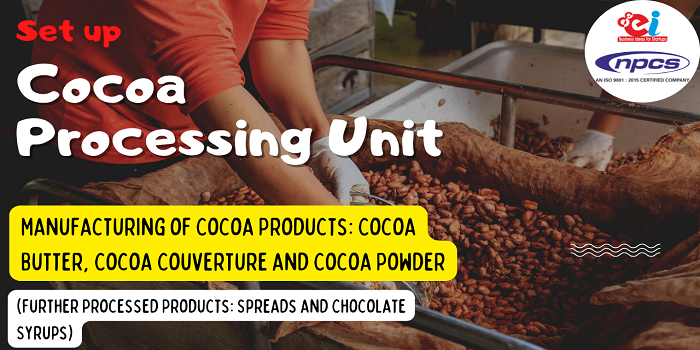Introduction
A cocoa processing unit is a facility that converts cocoa beans into chocolate goods. These units are made up of multiple interconnected phases, as well as specialised equipment and skilled staff. The most significant phase in cocoa manufacturing is fermentation, which involves combining fermented and roasted cocoa beans with water to create liquid cocoa mass or liquor. When the alcohol content hits 2-3%, fermentation ceases. This combination is subsequently dried, yielding about 100kg of finished product for every tonne of raw material used in the fermentation process. Roasting, drying, winnowing (removing husks), grinding, and pressing are among of the other steps.
Read Similar Articles: Food Processing and Agriculture Projects
At several points during the manufacturing process, cocoa butter can be extracted. Each stage requires various machines, all of which must be constantly monitored in order to make high-quality chocolate with consistent flavour and look. To impart certain properties to finished products, various additives such as sugar, milk powder, and lecithin may be added in addition to cocoa beans. Individual components such as cocoa powder and nibs for use in confectionery can range from solid bars of dark chocolate for sale in supermarkets to individual components such as cocoa powder and nibs for use in confectionery. Some companies sell their final product straight to consumers, while others sell it to huge food producers who mix it with other ingredients before reselling it.
Business Plan: Set up Cocoa Processing Unit Cocoa Butter, Cocoa Couverture and Cocoa Powder (Further Processed Products: Spreads and Chocolate Syrups)
Uses
The range of applications for a cocoa processing machine is extensive, as it will aid in the growth of the sector as well as the generation of significant profits. Ground cocoa beans are melted with different proportions of other ingredients such as milk or sugar in the production of chocolate. For further mixing and shaping, the substance can be boiled or heated. It is then cooled until it is solid enough to eat.
Consider the following scenario: Cocoa powder is obtained by crushing roasted cocoa beans and is used to make chocolate bars and desserts. The majority of the unsaturated fat in cocoa butter can be extracted from natural cocoa powder by pressing; once separated, the unsaturated fat remains solid at room temperature (though it melts slightly above ). This substance is known as cocoa butter, and it can be used in a variety of ways.
Manufacturing Process
Before beginning the cocoa milling process, the all-purpose plant will be equipped with ovens for drying cocoa bean shells by circulation of hot air, as well as a dust remover with material dryer to remove all types of dust from bean shells. These dried beans are then transferred to a grinder to be ground into a fine powder. Then they go through a sifter, where they are divided into different sizes. The powder particles are then transferred to hammer mills, where they are further reduced in size. They pass through a refiner machine and emerge as white powder particles, which we refer to as cocoa butter or the fat phase of the chocolate producing process.
Market outlook
By 2020, the worldwide cocoa processing sector is expected to reach 4.46 million tonnes. Due to rising demand for cocoa butter and powder, which are used in the production of chocolate and other chocolate goods, the market is presently expanding. Between 2021 and 2026, the global cocoa processing market is predicted to increase at a CAGR of around 1.3 percent, reaching a volume of around 4.76 million tonnes. Cocoa is still a popular ingredient in the chocolate, culinary, and beverage industries. Flavonoids like theobromine and proanthocyanidins, which are recognised for their anti-aging, antioxidant, and anti-inflammatory qualities, are abundant in cocoa beans.
Related Feasibility Study Reports: Food Processing and Agriculture Based Projects, Snack Food, Frozen Food, Agro Processing Technology, Processed Food, Instant Food, Food Industry, Food Preservation, Canned Food, Packed Food, Ready to Eat Food, Cereal Food, Pickle, Spices, Grain Milling
They also aid to lower the risk of heart failure, arrhythmia, and cardiomyopathy, which are all cardiovascular illnesses. As a result of these characteristics, demand for cocoa-based products such as energy bars has increased among health-conscious customers. Cocoa is used in a variety of businesses besides food, such as personal care. Cocoa butter is a frequent ingredient in over-the-counter skin care products such soap bars, lotions, creams, and lip balms because it moisturises the skin. In the pharmaceutical sector, cocoa products are utilised as flavouring agents and coatings for medicines and vitamins.
Watch other Informative Videos: Food Processing and Agriculture Based Projects
Benefits
The processing of cocoa beans into cocoa butter and cocoa powder is one of the most profitable companies you can think of because it involves less capital and raw materials. Cocoa butter is used in the production of chocolate and confectionery, whereas cocoa powder is required in the production of popular chocolate drinks, drinking chocolate, and other hot and cold beverages. This is why they are always in high demand on both the domestic and international markets. In addition, compared to other crops such as coffee or tea, its production does not necessitate a large number of personnel. In comparison to coffee cultivation, which requires 100-200 people per hectare, you will only need 2-3 workers per hectare. That’s why we’re going to look at how you may start your own cocoa processing business from the ground up and earn from the rich profits!
See More Links:
Start a Business in Potential Countries for Doing Business
Best Industry for Doing Business
Business Ideas with Low, Medium & High Investment
Looking for Most Demandable Business Ideas for Startups
